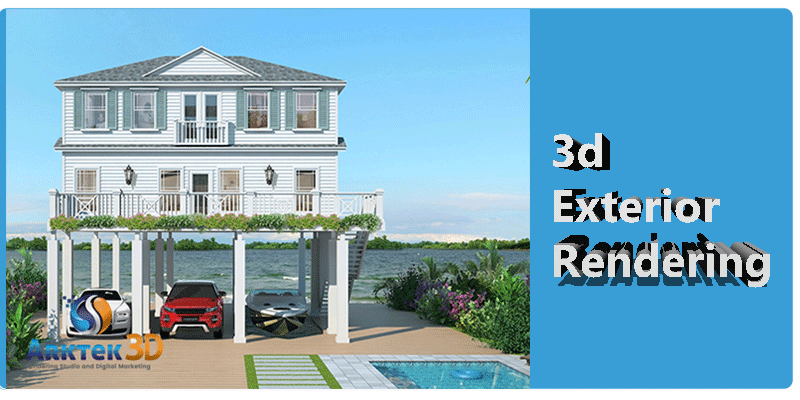Proper visualization of the architectural designs of a project is crucial for the builders, architects, developers, as well as designers. This helps them assess the quality and accuracy of the design prior to the commencement of the construction process. Well-developed 3D exterior rendering allows significant constructional issues to be detected early with efficiency in improvements.
Before we understand the types and applications of 3D architectural exterior rendering, here is a brief explanation of how this process works.
What is 3D Exterior Rendering & how does it work?
In simple terms, 3D exterior rendering can be dubbed as a collection of computer-generated images of a building’s exterior. It is crafted with the use of 3D software such as Maya, Sketchup, 3D Studio Max, etc. Architects or designers create 3D models for buildings along with landscape all around it. The first draft is created on the basis of architectural drawings, followed by lights and textures added later to the surroundings and final project image.
The resulting output is presented in the form of videos or images. The overall output can either be non-photorealistic or photo-realistic depending upon the requirements of the client.
Variants of 3D Architectural Exterior Rendering
Type-1: Commercial Buildings
3D exterior rendering for commercial buildings come with a collection of options. Here are the popular ones:
Skyscraper:
Skyscrapers are created by architects to reflect an impactful and modern design which can be used for commercial centers. It holds the potential to attract attention while associating the brand with fun and hi-tech technology.
Twinkly skylight with colorful advertising are the prime elements opted when designing a skyscraper with 3D exterior rendering technique.
The main focus when designing a skyscraper is to make it stand out from its surroundings while adding trendiest designs to create symmetrical makeup.
Resorts:
Resorts are meant to be a home away from the hustle and bustle of city life. When designing the perfect portfolio for resorts, the designers make sure that the house looks nothing less than a paradise. It is similar to a reserved structure that fits perfectly into a lush green backdrop.
With resorts, an architect needs to emphasize things such as soothing tranquility and perfect harmony with designs that are relaxing to the eyes. With the use of 3D architectural exterior rendering, practical simplicity should be the key factor when designing resorts.
Hotel Designs:
Hotel designs are exactly the opposite of skyscraper designs. A perfect night backdrop is ideal for 3D exterior rendering for hotel designs. The designs tend to be rather conservative depending on the requirements of the client. Such hotels are often surrounded with similarly elegant constructions.
Highlighting the area all around is quite imperative when it comes to designing the perfect hotel for clients. Picking the night mode for hotel 3D exterior rendering highlights the lighting through window panes and doors.
Office Building:
The design of an office building is mostly crafted in a way that it attracts the interest of potential customers while highlighting the elements that build trust in a firm. The office building front view is generally highlighted with impactful glass vestibules with minor insight into the conference room.
Most office buildings follow a geometrical design pattern to add sophistication to the overall construct. With office building, another factor of essence is the presence of parking space for the customers and clients. Properly facilitated parking created with 3D architectural exterior rendering tends to create an impression of a carefully planned facility.
Type-2: Residential Housing
Single Family House:
The 3D exterior rendering for residential projects such as a single-family home should be paired with simplicity, practicality, and impactful designs. The angle chosen for representing the exterior highlights are mostly an example of sophistication and simply shaped houses.
Warm & cozy colors with the crisp design of the chimney make the view all the more likable. Additionally, the architects should introduce elements such as blue sky, fallen leaves, and misty surroundings to reflect the perfect view for a potential buyer.
Multi-Family Residential Houses:
Multi-family houses are mostly created with 3D architectural exterior rendering to reflect eye-catching designs. The essence is to create a surrounding that looks conservative and wealthy while fitting in a super-modern house.
Slight rays of the sun highlighting the prominent features of the building make it all the more saleable among potential clients. Several architects and designers also add their own style statement by adding elements such as well-maintained gardens, green sidewalks, tall trees, etc.
Housing Units:
Most housing units are a part of areas that are away from the busy streets and tall skyscrapers. The idea here is to reflect a living space that in all sense is peaceful, calming, as well as detoxifying.
Creating a surreal yet achievable experience for 3D exterior rendering for housing units is of utmost importance. Housing units aren’t just houses; they are a well-told story of a balanced life where nature is a part of the surroundings.
Big Residence:
Big residences are mostly a whimsical mix of residences that reflect luxury and gorgeous surroundings. While designing the 3D architectural exterior rendering, impeccable panoramic views should be kept in mind.
Abundant greenery, breath-taking views, ample terrace space, and beautiful garden are some of the important features to be added onto the 3D exterior rendering design.
Bottom Line
While the general details remain the same, the exterior designs can be changed as per the requirement of the client. 3D exterior rendering is more about satisfying the needs of the client while adding subtle innovations to the overall idea. As a 3D artist, it is important that you pay attention to the smallest possible details such as geographical positions, target audience, cultural environment, and lighting.

